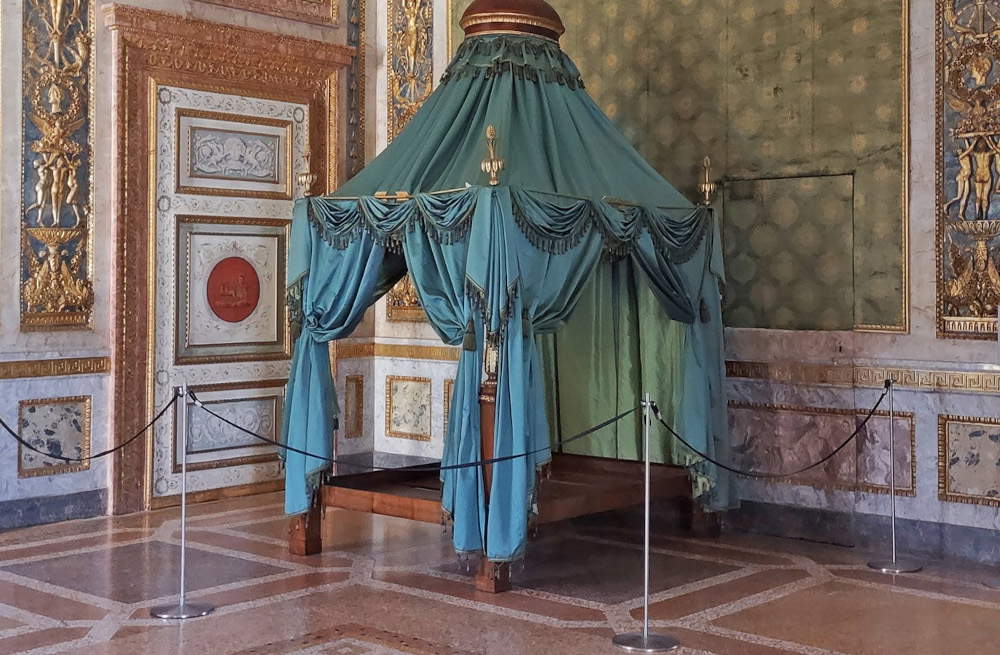In the Zodiac Room of the Ducal Palace in Mantua, Napoleon’s bed, where Bonaparte is said to have slept during his stay in Mantua, is back on display.
From 1797 to 1799 and from 1801 to 1814 the city was ruled by the French. In this second phase, more precisely in 1805, the Ducal Palace of Mantua was chosen as one of the imperial residences. In those years, major restoration and renovation work was undertaken, with the intention of restoring splendor to the rooms of the Palace. In addition to maintenance work, necessary to save many of those rooms from decay, an exceptional decorative campaign was launched between 1812 and 1813, in neoclassical taste, coordinated by the Faenza architect Giuseppe Pistocchi and the Larian painter Agostino Comerio, alluding to Napoleon’s triumphs. Among the various personalities we find Mantuan painters such as Carlo Bustaffa and Alessandro Ferraresi, the Cremonese Francesco Tartagnini, the architect former assistant to Paolo Pozzo Giovan Battista Marconi, the plasterer Girolamo Staffieri, and the gilders Anselmo Mecchi and Gaetano Obè.
The campaign mainly affected the rooms on the main floor of the Corte Vecchia, where the apartments for the emperor and empress were set up. The wrought floors (seminato veneziano) still present in Corte Vecchia today were also made. Although many of these decorations have been lost, some important evidence of this phase of the Ducal Palace’s long history still remains.
In the Hall of the Zodiac it is still possible to notice the gilded neo-Egyptian pilasters, Antonio Ruggeri’s faux bronze bas-reliefs with Minerva presents the arts and sciences to Napoleon, Napoleon receives the sword of Mars from Jupiter, Napoleon accepts the products of the earth, and Italy offers laws to Napoleon. To complete this collection of neoclassical traces, the so-called “Napoleon’s Bed,” previously dismantled to allow for a maintenance restoration, has been relocated here: an elegant canopy adorned with green fabrics and cloths, whose placement in the Zodiac Room is historical or at least dated.
That it is Napoleon’s bed, says Nino Giannantoni, who describes it in 1929 in the very Zodiac Room: “in the shape of a field tent, covered with a heavy green silk fabric stopped by gilded wooden arrows, it served at the repose of Napoleon, passing through Mantua in 1797 general in the first Italian campaign, and then as emperor in 1805.” The first inventory of the Reggia that seems to mention the bed is dated 1810: “Musket bed composed of a bedstead with gilt bands and fillets with scalloped feet set in white and gold, four pieces of green satin ridò and similar blanket, the whole surrounded with fringe of green silk and fine gold with matarasso of feathers, and three of wool, and two pillows also of wool the whole with lining of fine white cottone,” estimated 1300 liras. Later inventories attest that the bed was in the Zodiac Room in 1812, but it was moved many times and was basically set up between the adjoining Tapestry Rooms and the “Room of the Signs of the Zodiac.”
 |
| Napoleon's bed is back on display in Mantua's Ducal Palace |
Warning: the translation into English of the original Italian article was created using automatic tools. We undertake to review all articles, but we do not guarantee the total absence of inaccuracies in the translation due to the program. You can find the original by clicking on the ITA button. If you find any mistake,please contact us.